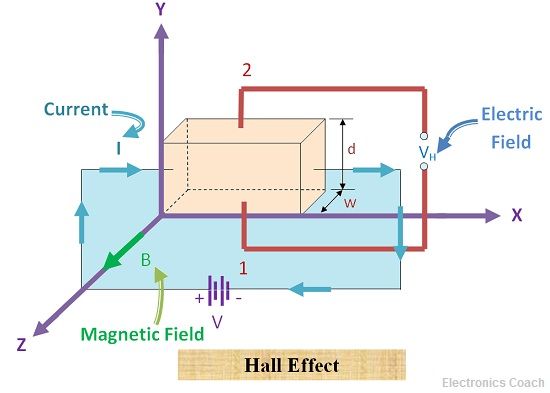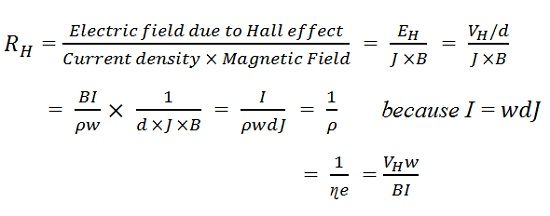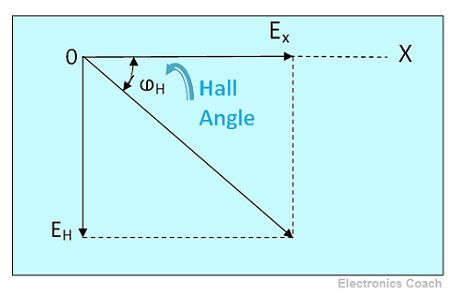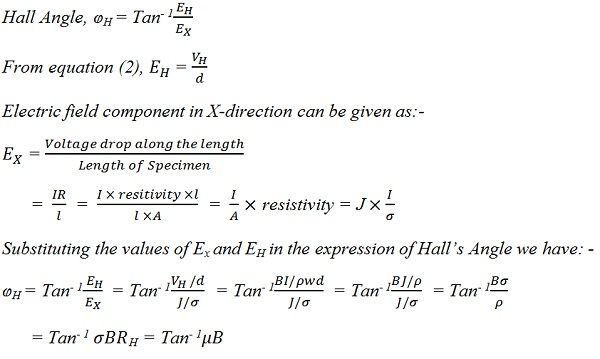Definition: When a piece of metal or semiconductor is placed in magnetic field, more precisely in transverse magnetic field, and direct current is allowed to pass through it, then the electric field gets developed across the edges of metal or semiconductor specimen. This phenomenon is called Hall Effect.
Explanation of Hall Effect
Consider a piece of metal is placed in magnetic field. And the magnetic field is perpendicular to the metal or semiconductor specimen. Now, direct current is passed through the metal or semiconductor specimen in such a way that direction of flow of current is along the positive direction of X-axis.
The magnetic field is applied in such a way that magnetic field acts along the positive direction of Z-axis. According to co-ordinate geometry, X-axis, Y-axis and Z-axis are perpendicular to each other. Thus, the current carrying path is perpendicular to the path along which magnetic field is acting.

The magnetic field is acting along positive Z-direction thus North Pole can be considered upward to the metal slab and South Pole can be considered downward to the metal slab. Therefore, when current starts flowing in a metal slab the charge carriers will experience force exerted by magnetic field.
The charge carriers which are flowing along the positive direction of X-axis will be pushed downwards due to magnetic force. In N-type semiconductor the major current carrying component is electron, thus these electrons will be pushed downwards. In the diagram illustrating Hall’s Effect it is quite evident that the bottom surface is numbered 1 and upper surface is numbered 2.
Thus, in N-type semiconductor when the semiconductor slab is placed in magnetic field the bottom surface of the semiconductor becomes more negative with respect to top surface i.e. surface 1 will be negative with respect to surface 2.
In case of P-type semiconductor the bottom surface will be more positive with respect to top surface i.e. the surface 1 will be more positive with respect to surface 2. This accumulation of charge carriers will create electric field. Thus, electric field will be perpendicular to both, the direction in which magnetic field is acting and the direction in which current is flowing.
Mathematical Expression of hall Effect
In the state of equilibrium the electric force exerted on charge carriers due to the electric field generated due to Hall’s Effect, will balance the magnetic force exerted on charge carriers due to magnetic field.

Therefore, the value of charge density can be determined if we know the values of B, I , VH and w.
Hall Co-efficient: The hall coefficient can be defined as the Hall’s field per unit current density per unit magnetic field. Mathematically it can be given as:-

In extrinsic semiconductor the current carrying charge carriers are of one type either electrons or hole, like in N-type semiconductor the charge carriers are electrons and in P-type semiconductor the charge carriers are holes. Thus, conductivity (σ) is given as:-
![]()
The relation between mobility (μ), conductivity (σ) and Hall’s co-efficient (RH) can be defined as:-
![]()
The above equation is derived by considering that the charge carriers are moving with the mean drift velocity v. While the charge carriers have a random thermal distribution of speed in actual case. Thus, according to such a random distribution the above equation can be redefined as:-

Hall Angle: The resultant electric field (E) (due to electric filed in X-direction (Ex) and Hall’s field acting in Y-direction(EH)) makes some angle with the electric filed in X-direction (Ex). This is called Hall Angle. This angle is denoted by ⱷH.


Applications of Hall Effect
The various applications of Hall Effect are as follows:-
- To Determine Polarity: It is used for determining the type of semiconductor that is either N-type or P-type.
- To Determine Carrier Concentration: It is used to determine the electrons and holes concentration.
- Determining Conductivity: Hall Effect is used to determine the conductivity of material and thus, its mobility can be calculated.
- Measuring Displacement and Current: It is used for the measurement of displacement and current in mechanical sensors.
- Power Measurement: Power measurement in an electromagnetic wave can be done with the help of Hall effect.
Hall effect holds significance in various sensing devices. Thus, it is important to understand its working in detail.
Leave a Reply